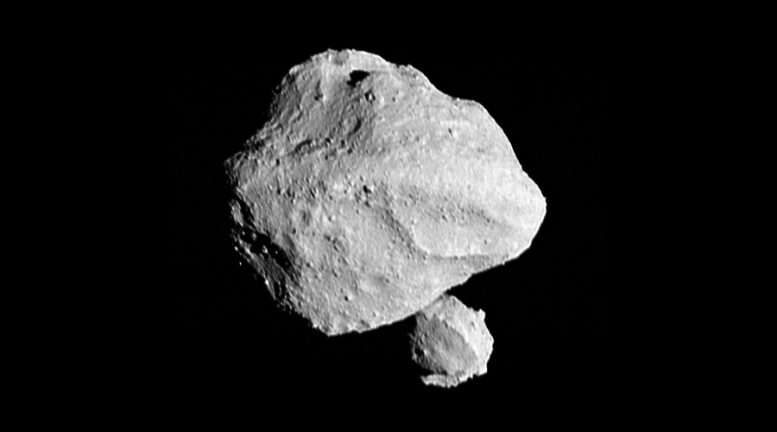
This image shows the “moonrise” of the satellite Selam as it emerges from behind asteroid Dinkinesh as seen by the Lucy Long-Range Reconnaissance Imager (L’LORRI), one of the most detailed images returned by NASA’s Lucy spacecraft during its flyby of the asteroid binary. The image has been sharpened and processed to enhance contrast. Credit: NASA/Goddard/SwRI/Johns Hopkins APL/NOAO
NASA’s Lucy spacecraft discovered that the asteroid Dinkinesh, also known as “Dinky,” is orbited by a satellite composed of two fused moons, collectively named “Selam.” This finding upends existing theories of celestial formation and enhances our understanding of the processes behind the evolution and formation of planetary bodies.
When NASA’s Lucy spacecraft flew past its first official target Dinkinesh in November 2023, scientists discovered that the asteroid—known as “Dinky”—was not alone in space. A satellite asteroid, which the team named “Selam,” was orbiting Dinky. As Lucy sent more data back to Earth, the researchers discovered something surprising: Selam was not just one moon, it was a contact binary—or two moons melded together.
New Findings Challenge Old Theories
The Lucy team, which includes University of Maryland Professor of Astronomy and Geology Jessica Sunshine, detailed the unexpected finding in a paper published in the journal Nature on May 29, 2024. The researchers noted that the unusual arrangement challenges existing theories about how asteroids and other celestial bodies formed over time and provides additional insight into the internal structure, dynamics and evolutionary history of both Dinky and Selam.
“There’s a lot more complexity in these small bodies than we originally thought,” said Sunshine, a co-author of the paper. “With the additional observations taken by the spacecraft, we were able to better analyze features such as Dinkinesh’s rotation speed and Selam’s orbit pattern. We also have a better understanding of what materials they’re possibly made of, bringing us a step closer to learning just how terrestrial bodies are created.”
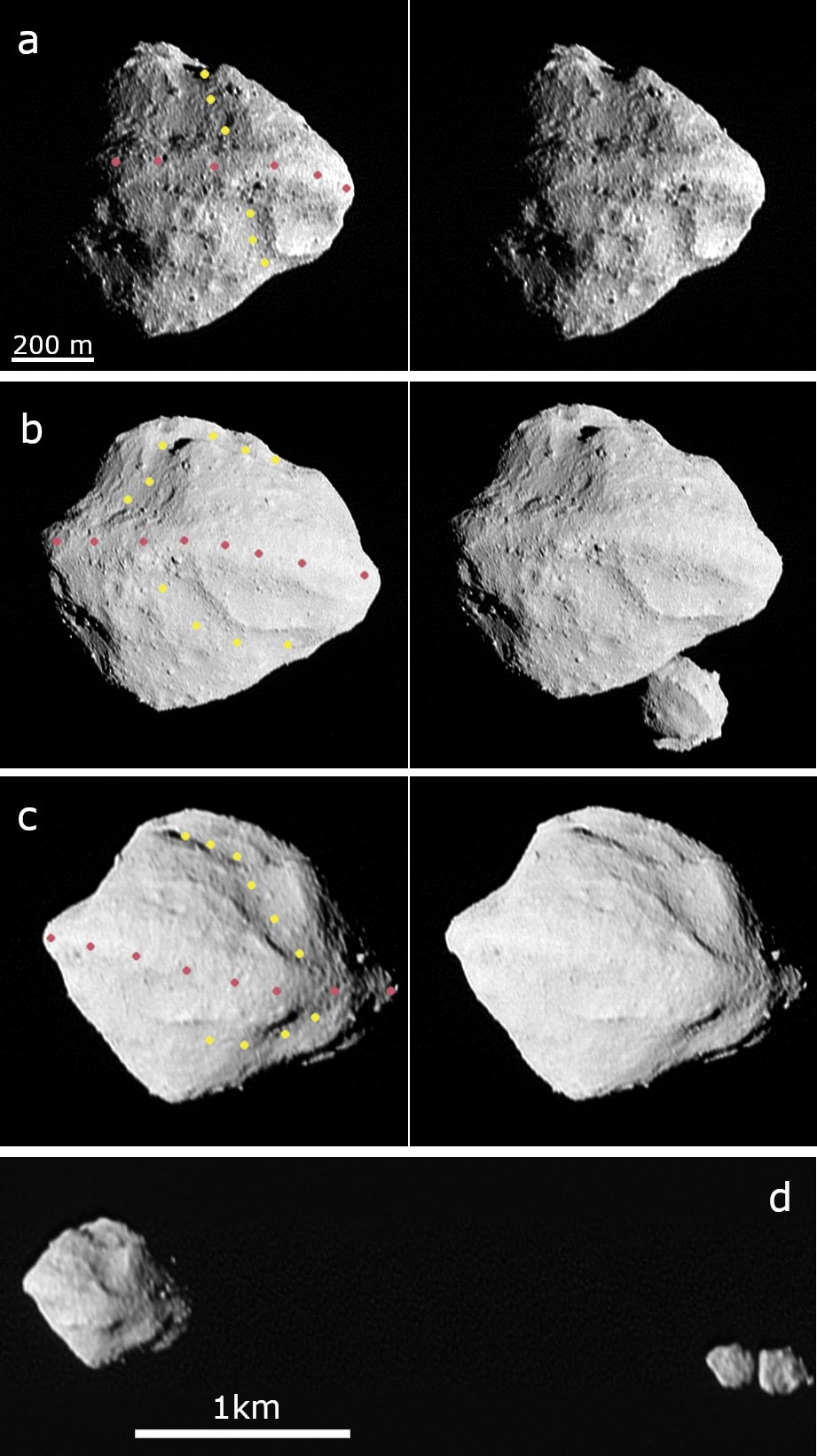
Panels a, b, and c each show stereographic image pairs of the asteroid Dinkinesh taken by the NASA Lucy Spacecraft’s L’LORRI Instrument in the minutes around closest approach on November 1, 2023. The yellow and rose dots indicate the trough and ridge features, respectively. These images have been sharpened and processed to enhance contrast. Panel d shows a side view of Dinkinesh and its satellite Selam taken a few minutes after closest approach. Credit: NASA/SwRI/Johns Hopkins APL/NOIRLab
The Formation of Dinky and Selam
Images taken by the Lucy spacecraft revealed a trough on Dinkinesh where about a quarter of the asteroid broke off from its main body, a ridge that formed after the asteroid’s structural failure and the contact binary now known as Selam (which was named after the child counterpart of the Lucy hominin fossil discovered in 1974).
The team theorized that Dinky’s fast spinning motion—boosted by the uneven reflection of sunlight off the asteroid’s surface—caused it to shed and eject rocky debris into orbit. Some of the debris could have aggregated to form Selam, while another portion of the fragments rained back down on Dinky as boulders and created the ridges photographed by the Lucy spacecraft.
Understanding Celestial Collisions and Their Impact
“One of the things that’s critical to understanding how planets like Earth got here is understanding how objects behave when they hit each other, and to understand that we need to understand their strength,” said lead scientist Hal Levison of Southwest Research Institute, Boulder, Colorado, principal investigator for the Lucy mission. “Basically, the planets formed when [smaller objects like asteroids] orbiting the Sun ran into each other. Whether objects break apart when they hit or stick together has a lot to do with their strength and internal structure.”
Comparative Studies of Celestial Systems
The team deduced that Dinky likely had some internal strength, which allowed it to maintain most of its form.
Just how Dinky’s unusual dual moons formed remains a mystery, but Sunshine said that the team’s findings open the door to comparative studies with similar celestial bodies.
“I’m personally very excited to compare the Didymos binary system with this one, especially as they appear to share many similarities such as size, general shape and possibly composition despite being in totally different parts of the solar system,” explained Sunshine, who was also on NASA’s DART research team and helped detail the DART spacecraft’s successful deflection of Didymos’ small moon called Dimorphos.
“The Didymos binary system is located in a near-Earth environment while the Dinkinesh system is located much farther away from Earth in the main asteroid belt,” she added. “They have very different features but we think they may have undergone similar processes to become what we know of them today.”
Lucy’s Ongoing Mission and Future Plans
Dinkinesh and its satellite are the first two of 11 asteroids that Lucy plans to explore over its 12-year journey. After skimming the inner edge of the main asteroid belt, Lucy heads back toward Earth for a gravity assist in December 2024. That close flyby will propel the spacecraft back through the main asteroid belt, where it will observe asteroid Donaldjohanson in April 2025, and then move on to observe the Trojan asteroids in 2027.
Exploring Planetary Formation Through Small Bodies
“Our ultimate goal is to understand the formation of celestial bodies,” Sunshine said. “How do planets form? How was Earth formed? We know that big planets are formed by smaller bodies, so studying these little asteroids lets us see how materials behave and interact on a smaller scale. With Dinky and the other asteroids we’re flying by, we’re laying the groundwork for understanding how planets are made.”
For more on this research:
Reference: “A contact binary satellite of the asteroid (152830) Dinkinesh” by Harold F. Levison, Simone Marchi, Keith S. Noll, John R. Spencer, Thomas S. Statler, James F. Bell III, Edward B. Bierhaus, Richard Binzel, William F. Bottke, Daniel Britt, Michael E. Brown, Marc W. Buie, Philip R. Christensen, Neil Dello Russo, Joshua P. Emery, William M. Grundy, Matthias Hahn, Victoria E. Hamilton, Carly Howett, Hannah Kaplan, Katherine Kretke, Tod R. Lauer, Claudia Manzoni, Raphael Marschall, Audrey C. Martin, Brian H. May, Stefano Mottola, Catherine B. Olkin, Martin Pätzold, Joel Wm. Parker, Simon Porter, Frank Preusker, Silvia Protopapa, Dennis C. Reuter, Stuart J. Robbins, Julien Salmon, Amy A. Simon, S. Alan Stern, Jessica M. Sunshine, Ian Wong, Harold A. Weaver, Coralie Adam, Shanti Ancheta, John Andrews, Saadat Anwar, Olivier S. Barnouin, Matthew Beasley, Kevin E. Berry, Emma Birath, Bryce Bolin, Mark Booco, Rich Burns, Pam Campbell, Russell Carpenter, Katherine Crombie, Mark Effertz, Emily Eifert, Caroline Ellis, Preston Faiks, Joel Fischetti, Paul Fleming, Kristen Francis, Ray Franco, Sandy Freund, Claire Gallagher, Jeroen Geeraert, Caden Gobat, Donovan Gorgas, Chris Granat, Sheila Gray, Patrick Haas, Ann Harch, Katie Hegedus, Chris Isabelle, Bill Jackson, Taylor Jacob, Sherry Jennings, David Kaufmann, Brian A. Keeney, Thomas Kennedy, Karl Lauffer, Erik Lessac-Chenen, Rob Leonard, Andrew Levine, Allen Lunsford, Tim Martin, Jim McAdams, Greg Mehall, Trevor Merkley, Graham Miller, Matthew Montanaro, Anna Montgomery, Graham Murphy, Maxwell Myers, Derek S. Nelson, Adriana Ocampo, Ryan Olds, John Y. Pelgrift, Trevor Perkins, Jon Pineau, Devin Poland, Vaishnavi Ramanan, Debi Rose, Eric Sahr, Owen Short, Ishita Solanki, Dale Stanbridge, Brian Sutter, Zachary Talpas, Howard Taylor, Bo Treiu, Nate Vermeer, Michael Vincent, Mike Wallace, Gerald Weigle, Daniel R. Wibben, Zach Wiens, John P. Wilson and Yifan Zhao, 29 May 2024, Nature.
DOI: 10.1038/s41586-024-07378-0






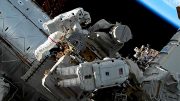
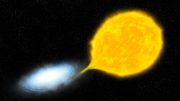
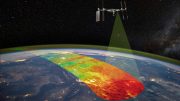
Be the first to comment on "Double Moon Mystery: NASA’s Lucy Unravels Dinky’s Secret"